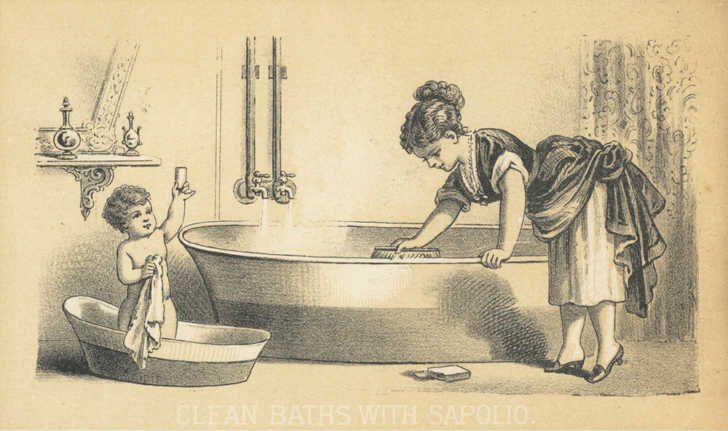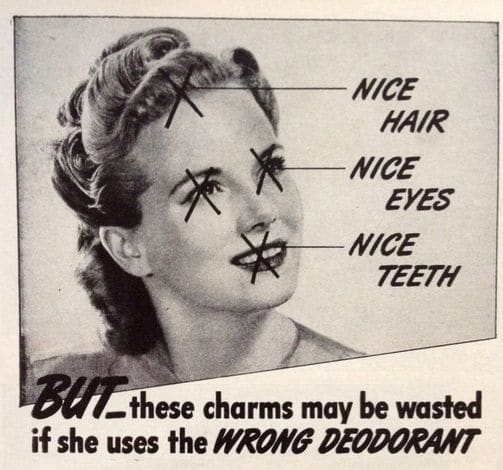
Odor-o-no – How marketers tricked billions to fear their body odor... (7 min read)
tl;dr - Odor-o-no history in 30 seconds or less
Personal hygiene products, including deodorants, have been aggressively pushed into our societal norms.
- Not long ago, in the early 1900s, the notion of using deodorants was widely dismissed as inappropriate and unnecessary.
- Ruthless advertising campaigns manipulated young women into thinking deodorants were absolutely essential to avoid complete societal rejection and humiliation.
- 100 years later, the deodorant and antiperspirant industry is worth over $30 billion.

A short intro about culture back then
Personal hygiene is kinda new invetion in our society.
A few hundred years ago, you couldn't convince someone to bathe, even for money.
King Louis XIV, 300 years ago, is often rumored to have proudly claimed he only bathed 2 times in his life - once when he was born and the second time on his wedding day.
People preferred to cover their stink with perfume - the aristocrats, of course.
And to prevent sweat marks on their clothes, people put cotton or rubber pads placed in the armpit areas.
But then a cultural shift happened - the Victorian Era
(1837–1901)
The 6th cholera outbreak was enough for people to start paying attention to personal hygiene.
The invention of sewer systems, health education, and easier access to soap led to bathing becoming more frequent - about once per week.
To handle body odour, people used perfumes, at least those who could afford them. The rest either didn't use anything at all or used things like vinegar or talcum powders.
Yet, still, talking about certain bodily functions was considered inappropriate. People simply pretended this subject did not exist.
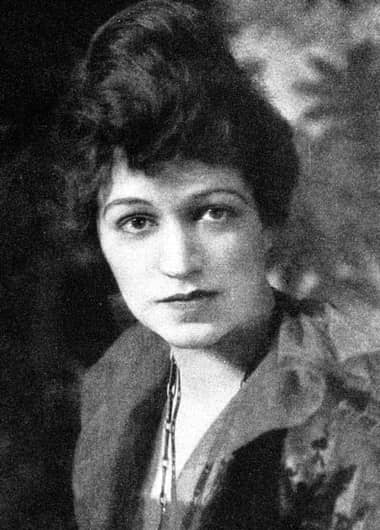
Enters Edna Murphey
The first commercial deodorant 'Mum' was invented in 1888. Not much later, in the 1900s, Mum lost market share to 'Everdry' antiperspirant.
But it would be the Odor-o-no (Odor? Oh No!) that would change the world.
Edna Murphey, the high school student from Cincinnati, for 2 years had been trying unsuccessfully to promote the antiperspirant that her father, a surgeon, had invented to keep his hands sweat-free in the operating room.
Edna first sold the product to her friends. She then tried to sell Odor-o-no to many drug stores, but every time she was turned down.
She believed so much in the product, in 1910, she borrowed $150 ($5k today) from her grandfather and opened an office. Unfortunately, it only lasted 5 months...
The business soon ran out of money and Edna moved the office into her parents’ basement.
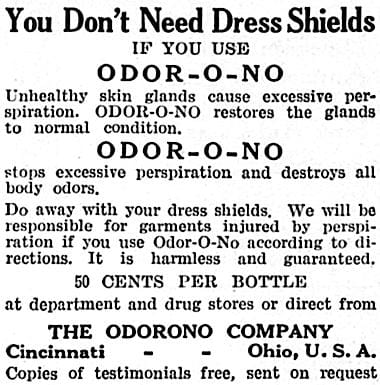
Breakthrough - Sell to a hungry crowd
In 1912, Murphey secured a booth at an Atlantic City exposition. Although it initially appeared to be an another bust, when people found themselves sweating a lot in the summer heat, interest in the product increased.
By 1913, Edna spent $4k ($125k today) on small newspaper ads, leading to $30k ($920k today) in sales.
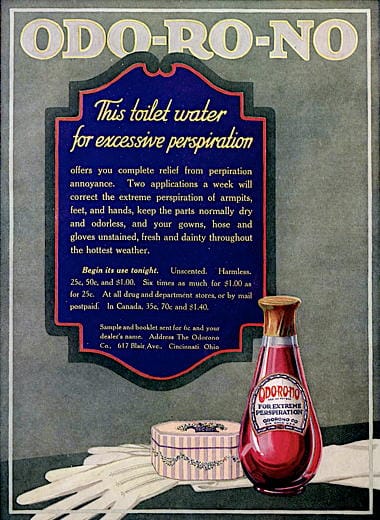
Why everybody hates marketers... (part 1)
In 1914, after taking a $50k ($1.5M today) bank loan, Edna hired Thompson agency and their copywriter James Webb Young (newbie back then, copywriting legend today) to take over Odor-o-no's advertising.
*It was also the time when Odor-o-no's name was changed to Odo-ro-no. Probably due to its pronunciation.
To overcome the fear of deodorant's safety, the agency presented Odo-ro-no as an authority with such headlines as:
“Excessive perspiration -what causes it - how to cure it.”
All of a sudden, perspiration became a disease women needed to cure.
They also attached Odo-ro-no samples above the ads in newspapers.
Within a year, the product was in every drugstore and the sales reached $65k ($2M today) in 1915.
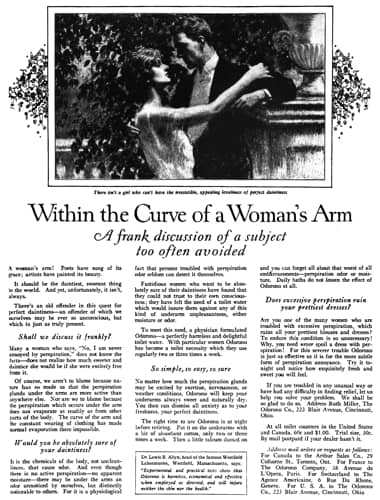
The ugly turn - How marketers convinced the world that perspiring women were repulsive (part 2)
Now, Odo-ro-no faced another dilemma - the stale growth. Through research, they found out that women knew about Odo-ro-no, but two-thirds of them felt they had no need for the product because they "did not suffer from excessive perspiration".
To convince the rest, Young made significant changes to their ads. They created a full-page, “sensational form” ad, combining romantic appeal with an insidious twist, and a Machiavellian headline:
“Within the Curve of Women’s Arm. A frank discussion of asubject too often avoided.”
At first glance, the ad seemed to discuss romance and intimacy, but instead, it shamed women for natural body functions, to manipulate them to buy products.
The ad appeared in the Ladies’ Home Journal in 1919.
Female readers were so offended by it that hundreds of them cancelled their magazine subscriptions.
But it worked...
Odo-ro-no's sales rose by 112% to $417k ($6.5M today) over the next year.
The era of the new, “your bestfriend won’t tell you” theme ads has begun.
Other brands and markets exploited this strategy as well for another decades.
In 1929, Edna sold Odo-ro-no to the Northam Warren company for $3.5M ($63.5M today)

The aftermath
Odo-ro-no reshaped our culture:
- First providing a quick solution to the Problem Aware people who were anxious about their excessive sweating.
- And when the Odo-ro-no's growth staled, they targeted people Unaware of the problem. They stopped convincing them, they needed to hide their smell. And started lecturing, that the smell itself is a social suicide.
Edna and the Thompson agency started the era of the "first impression" formula advertising.
The first impression an ad made on a potential customer was crucial in capturing their interest and influencing their perception of the product or brand.
All of a sudden ads made significant shift towards more sophisticated and psychologically driven techniques.
The formula's key components were:
- Headline
- Visuals
- Simplicity and clarity
- Emotional appeal
- USP (unique selling proposition)
Urban society had started to impose societal norms on appearance and material goods as a sign of a person's true character
By adating to the norms, people also avoided the ridicule, guilt, and other forms of emotional abuse.

Cultural Shift and Norms
During the Victorian era, people started to think cleanliness was important, not just a choice. This shift capitalized on the availability heuristic, where people judge the likelyhood of an event based on how easily they can recall similar events.
This change in thinking made everyone more aware of cleanliness because of stories about diseases and health advice.
The Mere Exposure Effect and Authority
The more often people have seen Odo-ro-no brand - Atlantic City exposition, magazine ads, pharmacies - the more they trusted the brand through the Mere Exposure Effect (the more you see something the more you trust it).
Plus, showing the product as a scientifically-backed solution to an "excessive perspiration disease" positioned the brand as an authority. People are more likely to follow the lead of an authority figure or entity.
Fear, Uncertainty, and Doubt (FUD)
James Webb Young was one of the first pioneers in utilizing fear, uncertainty, and doubt to manipulate consumers.
Suggesting that perspiration could lead to social ostracization ("social suicide"), the ads preyed on our natural human fears of exclusion and inadequacy. This fear-based strategy worked as it targets high negative emotional states, making the message more memorable.
Today, FUD is widely used in public relations, politics, polling, and cults - watch out in the upcoming elections.
Conclusion
The story of Odo-ro-no's is a testament to the powerful role psychology plays in consumer behavior. By understanding and leveraging human nature, marketers were able to transform the behavior of the whole society.
Was it ethical?
Hell NO!
But it happened.
Once again, marketers shaped our cultural norms and values...
It's a reminder to be aware of our core human emotions, biases, and beliefs. Just as a tool, they can be used for good. But just as easily they can, and already are quite often used to manipulate by the wrong people for the wrong causes.
Get your
"oh sh*t, this might work for us!"
moment in the next 5 minutes
Viral marketing case studies and marketing psychology principles that made hundreds of millions in months or weeks
In the first email:
- a step-by-step strategy that made $0-$30M within 9 weeks with $0 marketing budget (case study)
- cheatsheet (PDF) of 10 biases in marketing used by top 2% companies
Other than that:
- weekly original content that helps you STAND OUT by providing more perceived value with less work
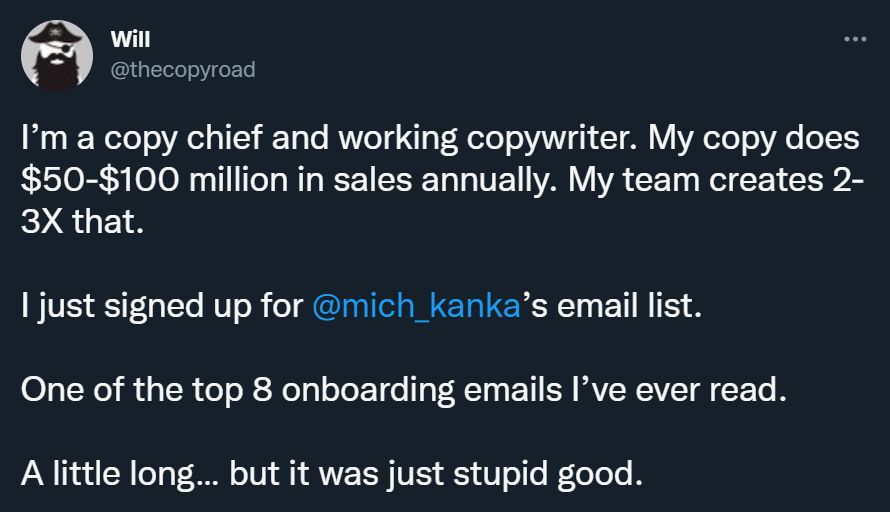
(You won't find it anywhere else)

Explore Cognitive Biases in Marketing
